By Rita Vainius
 The
impact of cross stitch on Charland Garvin's life is staggering and proof
positive is evident all around her everyday: needles in the couch, threads
on the floor, meals left uncooked. No particular event triggered this pervasive
obsession, but in hindsight, it is apparent that destiny was leading her
toward it all along.
The
impact of cross stitch on Charland Garvin's life is staggering and proof
positive is evident all around her everyday: needles in the couch, threads
on the floor, meals left uncooked. No particular event triggered this pervasive
obsession, but in hindsight, it is apparent that destiny was leading her
toward it all along.
 Charland
began her life in Great Falls, Montana. Her maternal grandmother's name
was Marie Matilde Sedulie Caroline Alexina Charland and it was in her honor
that Charland was named. Her interest in needlework goes back to time spent
with her other (paternal) grandmother whose patience she fondly recalls
when Charland first attempted sewing dresses for her clothes peg dolls
on the old treadle sewing machine. (Click on the picture on the right for
Charland's FREE Pattern.)
Charland
began her life in Great Falls, Montana. Her maternal grandmother's name
was Marie Matilde Sedulie Caroline Alexina Charland and it was in her honor
that Charland was named. Her interest in needlework goes back to time spent
with her other (paternal) grandmother whose patience she fondly recalls
when Charland first attempted sewing dresses for her clothes peg dolls
on the old treadle sewing machine. (Click on the picture on the right for
Charland's FREE Pattern.)
After graduating from Montana State College with a B.S. degree in Elementary
Education, Charland married her high school sweetheart, Bob. Immediately
afterwards they left for Uganda, East Africa where he had secured a teaching
position. Charland also taught there; her students were young women from
the Acholi tribe, experts at doing counted embroidery on a locally woven
cotton cloth, called "jinja," which they stitched with distinctive
designs in a brilliant assortment of bright, bold colors. Charland was
amazed by the painstaking effort exerted in executing these embroideries
and intrigued by the fact that they were done without the benefit of any
charts or designs. Such was her unorthodox introduction to counted thread
work.
 After
Charland and Bob returned from Africa, several other changes in locale
followed: Montana, Massachusetts, Missouri and Kentucky. By the time they
again left Montana, their family had grown to include three sons: Mitchell,
Chris, Matthew and one daughter Sydney. Once they had resettled in the
US, Charland got a job in the needlework department of a large fabric store.
With each move, she found positions in needlework related fields, adding
new skills at each. By the time the family settled down for good in Canada
17 years ago, Charland had experimented with enough needlework techniques
to know that cross stitch was her favorite.
After
Charland and Bob returned from Africa, several other changes in locale
followed: Montana, Massachusetts, Missouri and Kentucky. By the time they
again left Montana, their family had grown to include three sons: Mitchell,
Chris, Matthew and one daughter Sydney. Once they had resettled in the
US, Charland got a job in the needlework department of a large fabric store.
With each move, she found positions in needlework related fields, adding
new skills at each. By the time the family settled down for good in Canada
17 years ago, Charland had experimented with enough needlework techniques
to know that cross stitch was her favorite.
 Since
Charland's maternal grandmother was born in Quebec, and her paternal grandparents
hailed from Nova Scotia, she felt, on moving to Ontario, that she had returned
home. She established her own cross stitch shop in Toronto, named "The
Sampler." As an owner, she received requests for custom designs and
attempted these to accommodate her customers. Before long she was trying
out her own ideas. Her first published designs were a series based on the
widely loved storybook, Anne of Green Gables, as familiar a literary
heroine to Canadian children as Heidi is elsewhere.
Since
Charland's maternal grandmother was born in Quebec, and her paternal grandparents
hailed from Nova Scotia, she felt, on moving to Ontario, that she had returned
home. She established her own cross stitch shop in Toronto, named "The
Sampler." As an owner, she received requests for custom designs and
attempted these to accommodate her customers. Before long she was trying
out her own ideas. Her first published designs were a series based on the
widely loved storybook, Anne of Green Gables, as familiar a literary
heroine to Canadian children as Heidi is elsewhere.
For five years Charland's twin careers as shopkeeper and designer overlapped,
the latter finally winning out in 1994. Charland Designs have long since
gained a loyal following for their unique fresh quality and for a distinctive
personal "touch" which has become her trademark signature: a
silver "token", individually custom designed and applied to each
of her samplers. Charland had once seen Victorian sailor's token - a sterling
silver heart he would leave with his lady love before setting out to sea.
While browsing a trade show, the metallic glint of a charm caught her eye
and reminded her of that sailor's forget-me-not. She mused: "If you
are taking the time to stitch, why not use a really classy charm of sterling
silver?" But Charland went one better. Rather than use a mass produced
charm, she requested her sister, Barbara Greenberg, a professional sculptor
featured in our Gallery, to design one. While visiting Barbara at her home
in Holland, Charland was working on a sampler with a strawberry motif.
What was needed for a splendid finishing touch was a "proper"
strawberry charm. Barbara went out to her garden, picked one which was
growing wild, and proceeded to sculpt the perfect berry with her pocketknife.
Serendipity at its best! Since then Barbara has designed numerous charms
as decorative embellishments for Charland's samplers: a garden trowel,
spider, baby rattle, partridge, nutcracker - each essentially a miniature
sculpture which imbues each embroidery with panache and an individual personality.
Other embroideries have been complemented by charms produced by Charland's
son, Chris: rabbit, pineapple and antique bobbin.
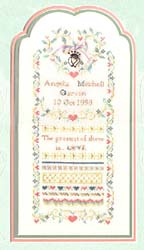 ----
----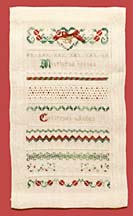 ----
----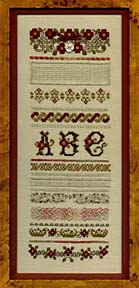
Inspirations abound for new design projects: flea market finds of old charms,
special celebrations and holidays are some of Charland's favorite themes.
The most important aspect of each design is color. Charland elaborates;
"Color speaks to me. I see a thread that I know I want to use because
the color is so glorious it makes you itch to stitch." An instinct
for how colors will interact in a pattern comes naturally to Charland.
Textures are created through the use of a variety of stitches, threads
and techniques. It is essential for all the elements to complement each
other so that they appear to flow together with a definite rhythm. "I
know when they feel right and are done. It is truly a feeling," Charland
insists.
Other hobbies, sewing and painting, also reflect Charland's tactile proclivities.
If it involves the hands and has a "touchy-feely" aspect, it
grabs her attention. This may also explain her preference for reading novels
as it requires holding book in hand!
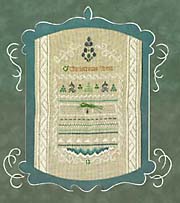 As
a shop owner Charland made Lois' acquaintance at trade shows and stocked
her threads in her store. As a designer, she finds them extremely adaptable
to her own style, enjoying especially their versatility in creating subtle
shading when moving from one color to another. Wildflowers are easily one
of her favorite threads, followed by Waterlilies and Soie Cristale which
add elegance, not only to the look, but also to the stitching process.
As
a shop owner Charland made Lois' acquaintance at trade shows and stocked
her threads in her store. As a designer, she finds them extremely adaptable
to her own style, enjoying especially their versatility in creating subtle
shading when moving from one color to another. Wildflowers are easily one
of her favorite threads, followed by Waterlilies and Soie Cristale which
add elegance, not only to the look, but also to the stitching process.
The patterns and format of many of Charland's pieces are inspired by traditional
band samplers, which were long narrow bands of fabric upon which rows of
patterns were stitched. Charland's fascination and respect for antique
samplers did not translate into enthusiasm for recreating them as they
generally require an inordinate amount of time to reproduce. In her own
designs, Charland aims to create contemporary embroideries with traditional
sampler nuances, while using a wide range of stitches and counted thread
techniques to ensure completion in a much shorter time. Band samplers are
especially well suited for such adaptation. Charland's ultimate goal for
the stitcher using her designs is that they are fun to stitch and fast
to finish without sacrificing the inherent element of challenge she strives
to maintain. As a teacher Charland urges her students to make their design
be what they want it to be and not to be a slave to the designer.
She suggests that each stitcher share in the design experience by changing
colors and altering stitches. The final product should be the stitcher's
personal statement. Charland enjoys teaching and is available by invitation
when her schedule permits.
When all is said and done, Charland hopes that her love for needlework
is evident in her designs and that the stitcher senses this as she plies
her needle. Charland is ever eager to impart the "itch to stitch"
to others.
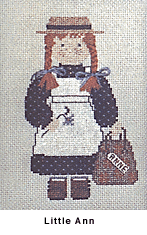 ---------
---------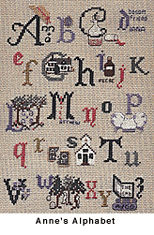
Charland's designs are sold to the trade and are widely available in needlework
stores throughout the US, Canada and Europe. For the location of a shop
which carries her designs, contact her at:
Charland Designs, Inc.
33 Deforest Road, Toronto, Ontario, Canada M6S 1J1
Phone: (416) 760 -9383
Fax: (416) 763- 1471
E-mail: charland1@aol.com
